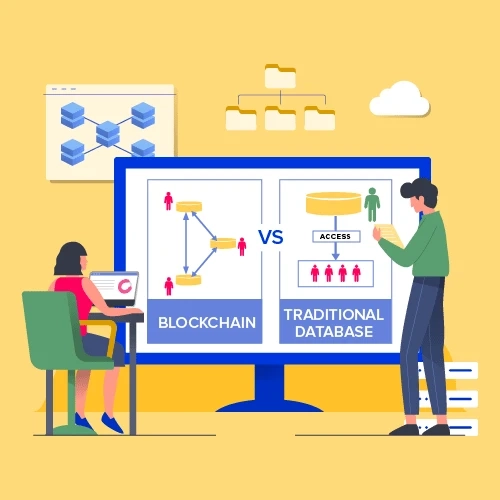Blockchain Technology has witnessed phenomenal growth in the last few years and appears to stay on track in gaining enterprise adoption. But while it has covered an appreciable curve of general acceptance, it continues to baffle people conceptually.
Striking similarities between Blockchain and databases makes people wonder “is Blockchain just a database?” Yes, Blockchain technology is a database that comes with several distinguishable traits. These traits are what lead to the debate of Blockchains versus traditional databases.
Therefore, in this post, we would systematically approach the definitions, similarities, and differences between the two to enable a better understanding of the subject for entrepreneurs and startups looking to explore blockchain.
What is a Traditional Database?
Data structures are defined as a storage format for efficient management of data. A traditional database is nothing but a data structure, that helps in storing and working with data. Each organization, from a startup to a Government entity, uses databases depending upon the scale and size of their operations. The aspect that makes databases utilitarian, is they allow users to fetch the data. In technical terms, this is referred to as requesting or querying data that is achieved by Structured Query Language, SQL.
The first-ever architecture of databases was based on a hierarchical style that made it possible to collect and store data. But that was just about it. As technology trends caught on with time, dragging the tide of businesses with it, data became complex. Likewise, analysts wanted databases to interoperate so they could draw better business conclusions. Thus, the database design shifted to a relational model. Today, all you need for an end-to-end data optimizing process is a Database Management System (DBMS).
Databases are no rocket science, in that they are simple tables. Tables are fields (columns) that contain the details regarding the nature of data. Rows are called records.
What is Blockchain?
Blockchain is a decentral database that acts as a storage for chunks of bundled information called blocks. The reason the blocks are referred to as chains is that each block carries the hashed data of the block added to the ledger before it. This goes back to Genesis, the first-ever block that was mined for bitcoin. A hash is a code that encrypts the transactions in a given block. This code is, essentially, a pointer, a name of sorts, that uniquely identifies a block.
The bitcoin protocol makes it mandatory for every new block to contain the hash of the previous block plus the hash of the block that contains information for newly processed transactions.
But as any blockchain application development company would tell you, finding this new hash isn’t easy. Blockchain technology underpinning bitcoin adjusts hashing difficulty by calculating the total computing power of the network. The more miners there are, the harder it is to find a hash and vice versa. In return for validating blocks and helping run the Blockchain, miners are rewarded with bitcoin.
Blockchain & Traditional Database Architectures
Defining the Traditional Database Architecture
Traditional databases are based on client-server architecture. Clients are end-users of the service that request access to a particular set of data. This request goes through a server that hosts the database. Open database connectivity is used to establish a communication line between clients and the database.
This line is further secured by the client software that is authenticated up ahead for access. In private databases, access is granted to only those who have valid login credentials and a password. An example could be confidential health records of a hospital. If a database is public and open for all, then a user account is not needed and the data can be accessed from a website. This, in turn, has played a huge role in Blockchain transforming the closed healthcare system.
Defining the Blockchain Architecture
Blockchain Technology has come of age and offers multiple architectural models such as permissioned, private, or hybrid blockchain.
Network nodes are the lifeline of Blockchain technology and they operate on a Peer-to-Peer, P2P, model. Each peer/node can correspond with a second node. There is no superiority or bias between 2 nodes in terms of responsibilities but yes, there could be a difference in total computing resources they possess. Peers of a network ensure the veracity of the Blockchain.
For the transactions to be manipulated either a 51% attack would need to happen (as mentioned above) or multiple peers would have to collude and accept blocks with falsified data. By architecture, Blockchain database technology protocols accept the longest-running, active chain. Therefore, its decentralized administration makes it safe and secure to be trusted and earns it extra points in the matchup of Blockchain vs distributed database.
Management of Traditional & Blockchain Database
Managing Traditional Database
Databases support CRUD operations i.e. you can create, read, update, and delete records. Database management is centralized and under the control of an administrator. This individual has the power to modify the database, potentially at will. Their key responsibility is to up the performance and lower database redundancy. As the database expands, so do the daily audits and the corresponding checklist of maintenance tasks.
To aid in this process, a primary administrator can divide his/her tasks and distribute work between multiple users, each assigned a minor task. This could be anything from data entry to modification.
Databases require backup storage as anything could go wrong. Data can be corrupt, servers could crash, and critical information could be lost. In such cases, the files are retrieved from backups. Backing up also allows archiving multiple versions of a database. As an example, consider an address change. Whereas you might contact relevant Government bodies to update “records” and issue you an ID reflecting the same, they will still save a copy of the last address, for record-keeping.
Read more about blockchain technology



